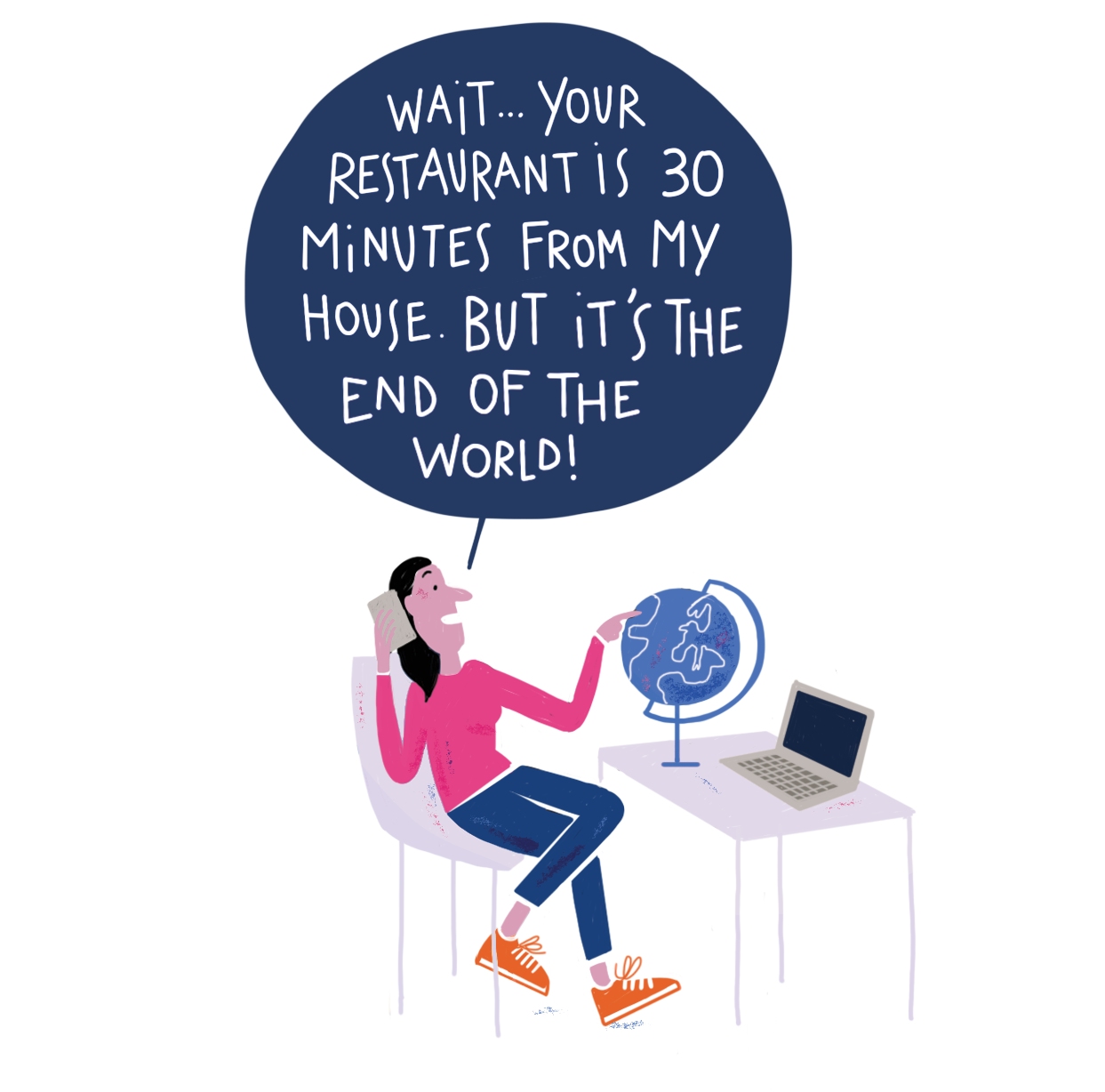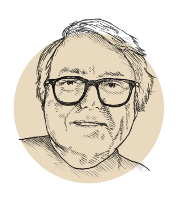Amid growing threats to our environment from climate change and pollution, we all know that urgent action is needed. One practical measure is to create cities that are livable, sustainable, and healthy. Places that are made up of connected neighborhoods forming a decentralized whole. Those of us fortunate enough to live in such a city are fully aware of the benefits. Within a 15-minute walk from my front door in Paris, I can buy a freshly baked baguette, browse a bookstore, send a package, dry-clean a shirt, walk in a park, do Tai chi, catch a bus or metro, rent a bike, see my doctor, buy lemongrass, and taste great wines. And while the city’s fancy department stores and luxury boutiques are beyond my quarter-hour perimeter, I can still pick up a “genuine” Hermès handbag for twenty euros from a guy on my street corner. With few exceptions, the same is true (bar the fake Birkin bag) across the twenty arrondissements, or districts, in Paris. And, to varying degrees in places such as Bordeaux, Rennes, or Strasbourg. So are these convivial, utilitarian, human-scale cities the blueprint for an environmentally sound future?
Some argue that the emphasis on cities comes at the detriment of rural areas, which are left to languish. But rural-to-urban migration is an inescapable fact. The movement has accelerated in the past 60 years, culminating in a global milestone in 2007 when the number of urban dwellers overtook those in rural areas. Today, more than half the world’s population – some 4.4 billion people – live in cities. That trend is unlikely to change, despite a minor and atypical reversal in the immediate aftermath of the Covid pandemic. On the contrary. According to the World Bank, the urban population will have more than doubled by 2050, meaning that seven out of ten people will be urbanites. In both France and the U.S., where more than 80% of the population now live in urban centers, managing this expansion successfully and sustainably is all-important because the benefits of urbanization must be equitably shared. One of the most talked-about models at the moment is la ville du quart d’heure, or 15-minute city, a term coined in 2015 at the COP21 climate conference in Paris.
In fact, the concept is neither new nor specifically French. Urban planners, sociologists and behavioral scientists have for decades been exploring ways to make cities more livable and pollution-free. One of the first of these innovators was the American urban planner Clarence Perry. In the early 20th century, he originated the idea of “neighborhood units,” where everything necessary for everyday life in a city could be found within a specific, limited boundary. Perry’s thinking was echoed by activists such as the New York urbanist Jane Jacobs, who argued that cities could provide something for everybody “only because and when they are created by everybody.” Such ideas formed the roots of New Urbanism, a movement to promote diverse, walkable, and environmentally friendly city districts. France in the 1960s adopted a masterplan to limit urban sprawl by building nine carefully planned villes nouvelles, or new cities, on the outskirts of major municipal centers, notably Paris. The idea behind these initiatives was to “re-humanize” urban life by putting all basic necessities within easy reach, with “easy” defined as a specific timeframe: for example 20 minutes for Portland, Oregon, or five minutes for Copenhagen, Denmark. (Some urbanists prefer the generic term “x-minute cities.”) All these plans and concepts existed in disparate forms for many years. The catalyst that brought them together was the Covid-19 pandemic when, by dint of necessity, people’s physical movements were confined to their immediate vicinity. As Lisa Chamberlain from the World Economic Forum (WEF) put it, “meeting all of one’s needs within a walking, biking or transit distance was suddenly a matter of life and death.” The pandemic, she said, created an urgency around equitable urbanism. And it transformed the 15-minute city from “a nice-to-have option into a rallying cry.”
It was then that the work of Carlos Moreno, a French-Colombian urbanist and professor at the Paris Sorbonne Business School, gained widespread recognition. Moreno, who cites Jane Jacobs as an inspiration, had been working on the 15-minute concept since well before the pandemic. His guiding principle has always been that cities should be designed or reconfigured so that all of their residents can satisfy six daily needs – accommodation, work, food, health, education, and culture and leisure – within a 15-minute walk or bike ride. Moreno’s ideas had a profound impact on Paris Mayor Anne Hidalgo, who was running for re-election in 2020 on a platform of creating a “city of neighborhoods.” The capital had long been known as la ville aux cent villages, or city of a hundred villages, and Hidalgo said she wanted to make that poetic, if wooly, concept a reality by focusing not just on how people travel from A to B within the city, but on making sure they live near the places that they need to get to. This, she said, would bring about “ecological transformation.” Mayor Hidalgo was voted back in with a comfortable majority, and also featured on Time magazine’s list of the 100 most influential people.

Of course, the 15-minute city concept is not specifically Parisian. It has been embraced by global organizations such as UN-Habitat, the WEF, and C40 Cities, which comprises the mayors of the world’s 96 largest urban centers. More significantly, it is being adopted not only by big urban centers such as Cleveland and Barcelona but also by small towns like La Montagne, near Nantes, and O’Fallon, Illinois, which apply the principles of proximity (shorter distances), diversity (varied land use), density (enough custom for local businesses), and ubiquity (a city that is available and affordable for all citizens).
It might seem, therefore, that small is once again beautiful. But not everyone thinks that the 15-minute city is a miracle cure for urban malaise. One of the main misgivings is the design and layout of existing cities, especially in the U.S., where the average trip for activities such as shopping or recreation is well beyond the 15-minute perimeter. A second, and more salient, drawback is the risk that social isolation or income-based segregation will be amplified. A city is, by essence, a place where people mix, interact, and share ideas across boundaries, both social and geographic. Yet many city neighborhoods, especially the poorest ones, lack a full range of amenities. And residents of the wealthier districts know only their cushioned comfort zone. Instead of leveling up, critics say, the inevitable result will be greater gentrification.
Carlos Moreno’s ville du quart d’heure won’t solve those problems overnight. In many cities and neighborhoods, a fundamental rethink will be necessary, along with huge investments. Moreno himself is well aware of this: “The 15-minute city is no magic wand,” he says. “It has to be adapted to each city’s local conditions.” Other naysayers – especially urban residents – seem to accept the concept in principle, so long as it’s not applied in their backyard. “A community center next door? No thank you!” In Paris, residents regularly bemoan the disruptions and disarray caused by seemingly interminable road work aimed at “civilizing” or redirecting traffic flows. Car owners, of course, are a vocal minority who decry a “war on automobiles.” And the extensive construction needed to reorganize the city has raised an outcry that is unlikely to die down in the near future.
Some of the criticisms venture into less rational – and, in some cases, crackpot conspiracy – territory. A quick visit to the wilder reaches of the Internet is instructive. The 15-minute city is just another form of social control, all the more pernicious for being couched in fancy language. Cities will be divided into fenced-in zones, not neighborhoods, and you’ll need a permit to travel outside your assigned zone. Governments will monitor your carbon footprint and you won’t be allowed to eat meat if you drive too far. And, of course, the endorsement of the WEF automatically means that the 15-minute city is part of an international socialist/communist/capitalist (take your pick) conspiracy to curtail personal liberties and usher in a Hunger Games society. Worst of all, the concept originates from a leftwing radical fanatic (Moreno was once part of a guerrilla group fighting the rightwing government in Colombia) who now lives – wait for it – in France, the home of cheese-eating surrender monkeys.
What’s sad about these half-baked claims is that they overshadow some of the questions that really need asking. Will resources be evenly distributed? Who will provide the services, and how will they be accessed? (One frequent reproach is the online migration of municipal facilities, which harms those with no access to computers.) Will segregation by ethnic origin become more deeply entrenched? Is total gentrification inevitable?
The last word should go to Carlos Moreno: “I’m not angling for cities to become rural hamlets,” he said in a TED talk. “Cities are places of economic dynamism and innovation. But we must make urban life more pleasant, agile, healthy, and flexible.” That might require more than a quarter-hour walk or bike ride, but the 15-minute city concept is definitely gaining ground. It might even be coming to a town near you.
Article published in the April 2023 issue of France-Amérique. Subscribe to the magazine.












